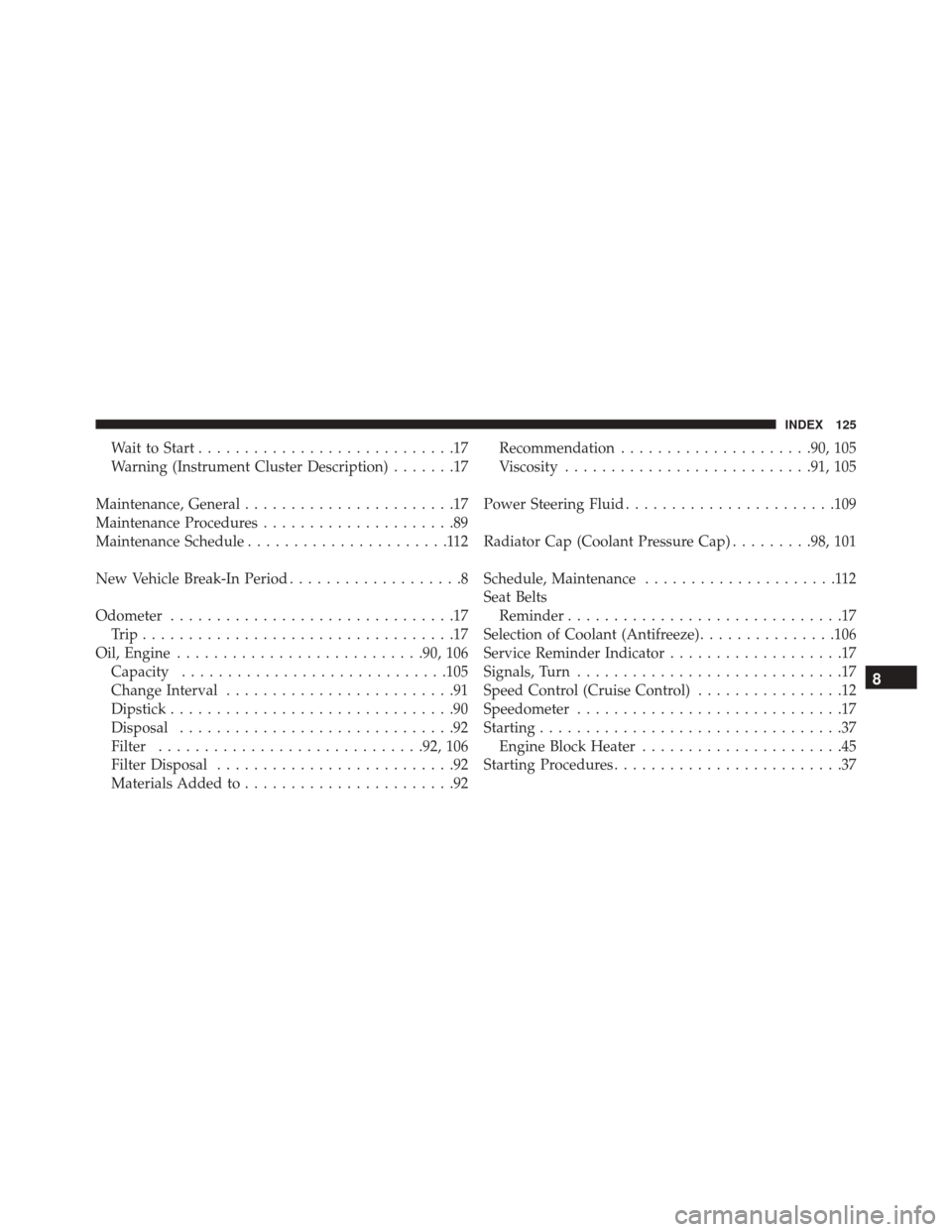Page 99 of 130

CAUTION!
It is essential when replacing the cables on the
battery that the positive cable is attached to the
positive post and the negative cable is attached to the
negative post. Battery posts are marked (+) positive
and negative (-) and are identified on the battery
case. Also, if a “fast charger” is used while the battery
is in vehicle, disconnect both vehicle battery cables
before connecting the charger to the battery. Do not
use a “fast charger” to provide starting voltage.
WARNING!
Battery posts, terminals, and related accessories con-
tain lead and lead compounds. Always wash hands
after handling the battery.
Cooling System
WARNING!
You or others can be badly burned by hot engine
coolant (antifreeze) or steam from your radiator. If
you see or hear steam coming from under the hood,
do not open the hood until the radiator has had time
to cool. Never try to open a cooling system pressure
cap when the radiator is hot.
Engine Coolant Checks
Check the engine coolant (antifreeze) protection every
12 months (before the onset of freezing weather, where
applicable). If the engine coolant (antifreeze) is dirty or
rusty in appearance, the system should be drained,
flushed and refilled with fresh coolant. Check the front of
the A/C condenser (if equipped) or radiator for any
accumulation of bugs, leaves, etc. If dirty, clean by gently
6
MAINTAINING YOUR VEHICLE 97
Page 100 of 130

spraying water from a garden hose vertically down the
face of the A/C condenser (if equipped) or the back of the
radiator core.
Check the engine cooling system hoses for brittle rubber,
cracking, tears, cuts and tightness of the connection at the
coolant recovery bottle and radiator. Inspect the entire
system for leaks.
With the engine at normal operating temperature (but
not running), check the cooling system pressure cap for
proper vacuum sealing by draining a small amount of
engine coolant (antifreeze) from the radiator drain cock.
The radiator drain cock is located in the lower radiator
tank. If the cap is sealing properly, the engine coolant
(antifreeze) will begin to drain from the coolant expan-
sion bottle. DO NOT REMOVE THE COOLANT PRES-
SURE CAP WHEN THE COOLING SYSTEM IS HOT.Cooling System — Drain Flush And Refill
If the engine coolant (antifreeze) is dirty or contains a
considerable amount of sediment, clean and flush with a
reliable cooling system cleaner. Follow with a thorough
rinsing to remove all deposits and chemicals. Properly
dispose of old engine coolant (antifreeze).
Refer to the “Maintenance Schedule” for the proper
maintenance intervals.
Selection Of Coolant
Refer to “Fluids, Lubricants, And Genuine Parts” in
“Maintaining Your Vehicle” for further information.
98 MAINTAINING YOUR VEHICLE
Page 103 of 130

•Mixing engine coolant (antifreeze) types is not recom-
mended and can result in cooling system damage. If
HOAT and OAT coolant are mixed in an emergency,
have a authorized dealer drain, flush, and refill with
OAT coolant (conforming to MS.90032) as soon as
possible.
Cooling System Pressure Cap
The cap must be fully tightened to prevent loss of engine
coolant (antifreeze), and to ensure that the engine coolant
(antifreeze) will return to the radiator from the coolant
expansion bottle.
The cap should be inspected and cleaned if there is any
accumulation of foreign material on the sealing surfaces.
WARNING!
• Do not open hot engine cooling system. Never add
engine coolant (antifreeze) when the engine is
overheated. Do not loosen or remove the cap to cool
an overheated engine. Heat causes pressure to
build up in the cooling system. To prevent scalding
or injury, do not remove the pressure cap while the
system is hot or under pressure.
• Do not use a pressure cap other than the one
specified for your vehicle. Personal injury or en-
gine damage may result.
Disposal Of Used Engine Coolant
Used ethylene glycol-based engine coolant (antifreeze) is
a regulated substance requiring proper disposal. Check
with your local authorities to determine the disposal
rules for your community. To prevent ingestion by ani-
mals or children, do not store ethylene glycol-based
6
MAINTAINING YOUR VEHICLE 101
Page 124 of 130

Adding Engine Coolant (Antifreeze).............99
Adding Fuel ..............................66
Air bag Light .............................17
Air Cleaner, Engine (Engine Air Cleaner Filter) .....92
Antifreeze (Engine Coolant) ...............98, 105
Disposal ............................. .101
Anti-Lock Warning Light .....................17
Automated Manual Transmission Fluid Type ........................... .109
Battery .................................96
Brake Fluid ............................ .109
Brake System ........................... .103
Fluid Check .......................... .103
Master Cylinder ....................... .103
Warning Light ..........................17
Capacities, Fluid ......................... .105Caps, Filler
Oil (Engine) ............................91
Radiator (Coolant Pressure) ................101
Check Engine Light (Malfunction Indicator Light) . . .17
Coolant Pressure Cap (Radiator Cap) ...........101
Cooling System ...........................97
Adding Coolant (Antifreeze) ................99
Coolant Capacity ...................... .105
Coolant Level ...........................97
Disposal of Used Coolant .................101
Drain, Flush, and Refill ....................98
Points to Remember .....................102
Pressure Cap ......................... .101
Radiator Cap ......................... .101
Selection of Coolant (Antifreeze) .......98, 105, 106
Cruise Light ..............................17
Diesel Exhaust Fluid (DEF) ..................106
Diesel Fuel .......................... .60, 106
122 INDEX
Page 127 of 130

Wait to Start............................17
Warning (Instrument Cluster Description) .......17
Maintenance, General .......................17
Maintenance Procedures .....................89
Maintenance Schedule ......................112
New Vehicle Break-In Period ...................8
Odometer ...............................17
Trip..................................17
Oil, Engine .......................... .90, 106
Capacity ............................ .105
Change Interval .........................91
Dipstick ...............................90
Disposal ..............................92
Filter ............................ .92, 106
Filter Disposal ..........................92
Materials Added to .......................92 Recommendation
.....................90, 105
Viscosity .......................... .91, 105
Power Steering Fluid ...................... .109
Radiator Cap (Coolant Pressure Cap) .........98, 101
Schedule, Maintenance .....................112
Seat Belts Reminder ..............................17
Selection of Coolant (Antifreeze) ...............106
Service Reminder Indicator ...................17
Signals, Turn .............................17
Speed Control (Cruise Control) ................12
Speedometer .............................17
Starting .................................37
Engine Block Heater ......................45
Starting Procedures .........................37
8
INDEX 125